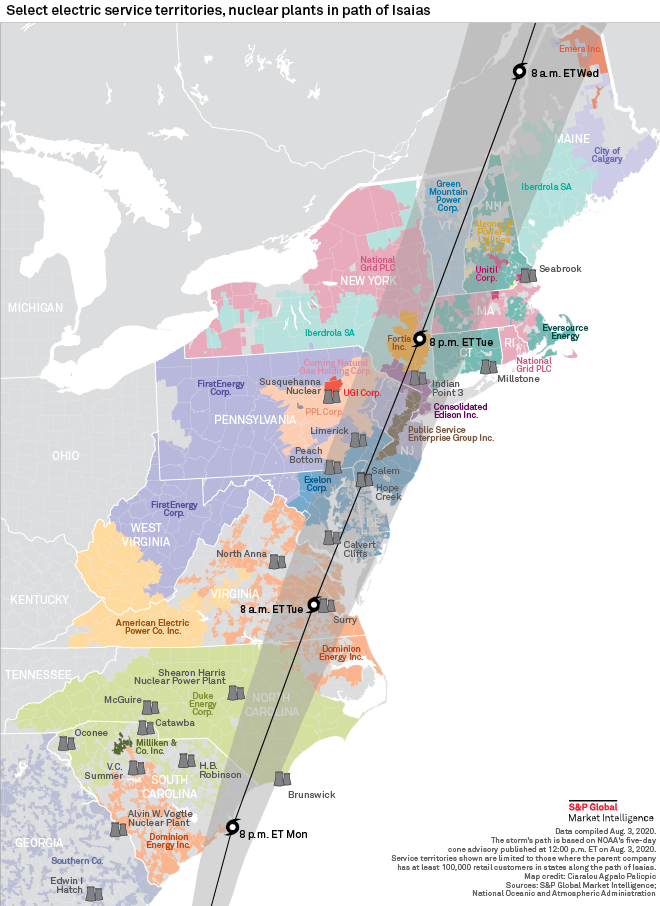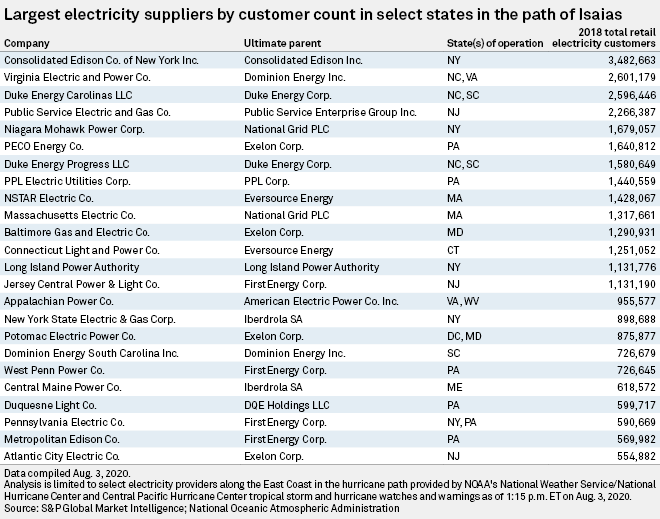Tens of millions of electric utility customers from South Carolina to Maine and roughly 35,000 MW of nuclear plant capacity are in the path of Tropical Storm Isaias, which the U.S. National Oceanic and Atmospheric Administration on Aug. 3 forecast to intensify into a hurricane as the evening progressed.
Various warnings, including hurricane, tropical storm and storm surge, were in effect all along the U.S. East Coast, with landfall expected in northeastern South Carolina or southern North Carolina.
From there, according to the 5 p.m. ET forecast from NOAA's National Hurricane Center, the center of the storm will move inland over eastern North Carolina, then through the Mid-Atlantic states to the northeastern U.S. by the evening of Aug. 4.
Many jurisdictions are expected to see 3 to 6 inches of rain, with eastern New York and portions of New England getting 2 to 4 inches, sparking flash flooding concerns.

Duke Energy Corp., through its Duke Energy Carolinas LLC and Duke Energy Progress LLC subsidiaries, serves about 4.2 million electric customers in North and South Carolina. Two of the company's North Carolina nuclear plants, the 1,928-MW Brunswick facility in Brunswick County and 1,009-MW Shearon Harris Nuclear Power Plant in Wake County are located closest to the path of the storm. Nuclear plant operators may shut down their facilities depending on wind speeds.
Duke Energy, in a July 31 press release, said it had to adjust its power restoration procedures to accommodate the need to social distance and keep utility crews safe amid the coronavirus pandemic. Duke Energy and members of the Edison Electric Institute, an association of U.S. investor-owned utilities, had tested enhanced safety and adjusted restoration protocols to account for social distancing and COVID-19 during major storms that hit 21 states in April, EEI said in an Aug. 1 press release.
In the Mid-Atlantic region, Dominion Energy Inc. subsidiary Virginia Electric and Power Co. d/b/a Dominion Energy Virginia's 1,750-MW Surry plant in Surry County, Va., was in the forecast storm path. Dominion Energy Virginia and affiliate Dominion Energy South Carolina Inc. serve more than 3.3 million electric customers in Virginia, North Carolina and South Carolina.

Further north, in New Jersey, two nuclear plants, Hope Creek and Salem, were in the storm's forecast path. Public Service Enterprise Group Inc. owns the 1,190-MW Hope Creek station and co-owns the 2,328-MW Salem station with Exelon Corp.
PSEG utility affiliate Public Service Electric and Gas Co. serves about 2.3 million electric customers in New Jersey, while Exelon utilities in the Mid-Atlantic serve more than 4.4 million electric customers.
Other Exelon nuclear plants in the storm's projected path include the 1,768-MW Calvert Cliffs facility in Calvert County, Md., 2,386-MW Limerick facility in Montgomery County, Pa., and 2,627-MW Peach Bottom plant in York County, Pa., co-owned with PSEG.
Another PSEG affiliate, PSEG Long Island LLC, operates the electric system of publicly owned Long Island Power Authority, which serves about 1.1 million customers and was forecast to be hit by the storm later on Aug. 4. PSEG Long Island Vice President of Transmission and Distribution John O'Connell said the utility was expecting to receive support from other utilities and contractors to help restore power if needed.



